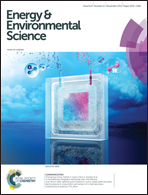Three dimensional corrugated organic photovoltaics for building integration; improving the efficiency, oblique angle and diffuse performance of solar cells†
Abstract
The lamination of OPV modules to corrugated roof cladding has been undertaken. The 3-dimensional form of the cladding provides three advantages for outdoor OPV deployment; firstly the ‘footprint’ of the solar cell is reduced, which leads to ∼10% improved power conversion (PCE) efficiency per unit area. Secondly, the oblique angle performance is enhanced, leading to increased output in the early morning and evening. Indoor characterisation showed a 9-fold enhancement in efficiency was obtainable, when compared to a flat module. Thirdly, an improvement in performance under diffuse lighting conditions was measured, when compared to a flat module. The average daily yield of the 3D module was 17–29% higher than a flat module, with higher relative enhancements observed on cloudier days. Geographically, the 3D module appears to be well-suited to countries with a high latitude, due to the enhanced diffuse light levels and the fact that tilting the module in both ‘latitude’ and ‘longitude’ directions away from normal, leads to the best achievable enhancement in solar cell performance. The approach set out in this paper could yield a product that has profound advantages over existing BIPV products and is potentially applicable to other flexible inorganic solar cell technologies.



 Please wait while we load your content...
Please wait while we load your content...